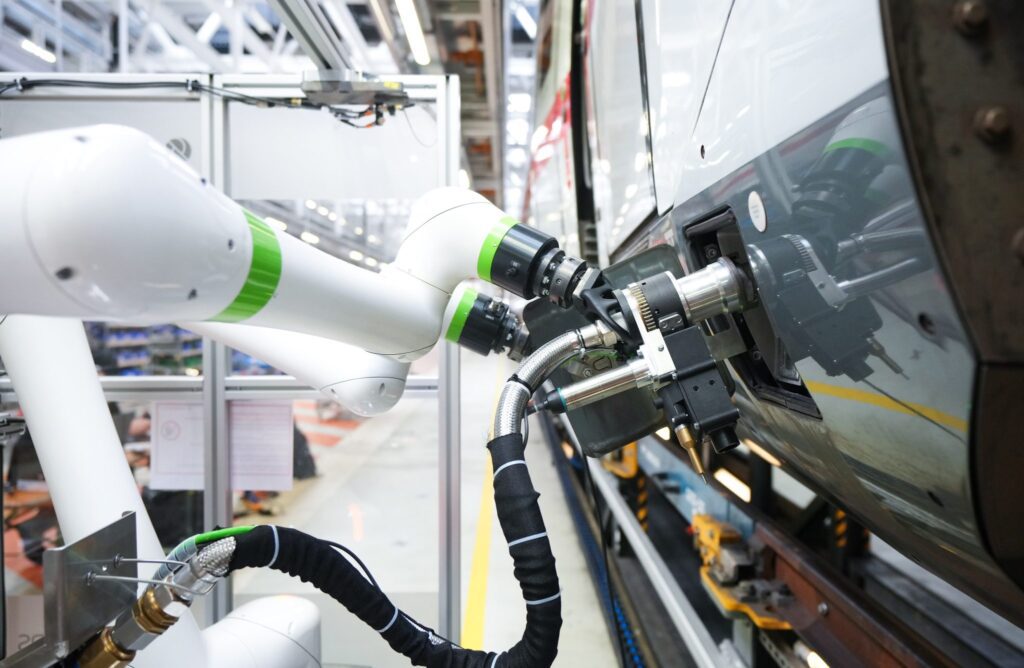TL;DR:
- Deutsche Bahn invests 55 million euros in E-Check process for ICE trains.
- AI and robots streamline inspections, water supply, and wastewater disposal.
- Cologne-Nippes ICE plant is the first to adopt this technology.
- Berlin, Dortmund, Hamburg, and Munich plants to follow suit by 2025.
- Aims to make maintenance more efficient with a growing fleet.
- E-Check reduces inspection time, detects minor defects, and frees up specialists.
- Specialized ‘cobots’ manage water supply and wastewater tasks.
- The process takes 1.5 hours, half the time compared to manual labor.
- Increases maintenance capacity on-site by 25 percent.
Main AI News:
Deutsche Bahn, a prominent player in the transportation industry, is making substantial strides in railway maintenance with a 55 million euro investment in its groundbreaking “E-Check” initiative. Leveraging the prowess of artificial intelligence and robotics, this cutting-edge project is set to transform the way ICE trains are inspected, while simultaneously enhancing passenger services.
The inaugural application of this innovative technology is taking place at the Cologne-Nippes ICE plant. Federal Minister Volker Wissing, alongside DB board member Michael Peterson, recently graced the premises to witness this transformative endeavor in action.
The E-Check initiative is poised to be rolled out across ICE plants in Berlin, Dortmund, Hamburg, and Munich by 2025. Deutsche Bahn’s objective is crystal clear: expedite and streamline the maintenance and inspection process to match the relentless growth of their fleet. On average, three new ICE trains are introduced into operation every month, making efficiency paramount.
The E-Check process entails a meticulously designed inspection protocol. As the ICE train gracefully glides through a camera gate, it undergoes a comprehensive evaluation that takes merely five minutes, even for the colossal 374-meter-long XXL ICE with 13 cars. Optionally, a mobile underfloor device can be deployed for a thorough examination of the train’s undercarriage. These captured visuals are then subjected to the discerning eye of an AI system. Any anomalies are promptly communicated to the on-site technicians. A technician carefully reviews the images, determining whether there is indeed a fault. If necessary, a work order is instantaneously dispatched to the workshop staff via tablet.
The sophistication of this technology is awe-inspiring. It has the capability to detect minute discrepancies, such as improperly seated screws or issues warranting immediate repairs. Furthermore, it doesn’t stop at functional defects; even “cosmetic defects” like damaged pictograms on the train’s exterior are identified.
Intriguingly, a vital aspect of the E-Check process is the deployment of specialized robots known as ‘cobots.’ These robots proficiently manage the task of replenishing fresh water and evacuating wastewater from the ICE trains. With remarkable precision, they autonomously recognize the connection points on different train types, promptly attaching the appropriate components. Once their task is accomplished, the cobots efficiently detach, close the access points, and seamlessly transition to the next trolley.
In comparison to manual labor, the entire E-Check process, inclusive of water supply and disposal, is completed in a swift one and a half hours—half the time it would take human personnel. Volker Wissing, Federal Minister for Digital and Transport, lauds this project’s amalgamation of digital innovation and human expertise. It not only relieves the workforce but also augments maintenance capacity on-site by a remarkable 25 percent.

A mobile robot supplies the ICE with fresh water and pumps out the waste water. Source: RailTech.com
Conclusion:
Deutsche Bahn’s E-Check initiative represents a significant leap forward in rail maintenance, integrating AI and robotics to streamline operations. This innovation not only enhances efficiency and reduces inspection time but also addresses the challenges posed by a growing fleet and a shortage of skilled workers. It showcases the potential of digital technology and human expertise, setting a new benchmark for the transportation market.

